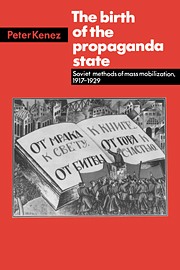Book contents
- Frontmatter
- Contents
- List of illustrations
- Preface
- Introduction: The Soviet concept of propaganda
- Part I The Civil War
- 1 The press
- 2 The struggle for the peasants
- 3 Liquidating illiteracy in revolutionary Russia
- 4 The Komsomol in the Civil War
- 5 The political use of books, films, and posters
- Part II The new economic policies
- Conclusion and epilogue
- Notes
- Glossary
- Bibliography
- Index
2 - The struggle for the peasants
Published online by Cambridge University Press: 02 December 2009
- Frontmatter
- Contents
- List of illustrations
- Preface
- Introduction: The Soviet concept of propaganda
- Part I The Civil War
- 1 The press
- 2 The struggle for the peasants
- 3 Liquidating illiteracy in revolutionary Russia
- 4 The Komsomol in the Civil War
- 5 The political use of books, films, and posters
- Part II The new economic policies
- Conclusion and epilogue
- Notes
- Glossary
- Bibliography
- Index
Summary
The Russian Revolution is best understood as a process in which authority collapsed. The institutions of the tsarist regime could not stand the test of a modern war, and the ideology of the tsar and his ministers was inappropriate at a time when circumstances demanded mass mobilization. The liberal ideology of the Provisional Government was no more capable of holding the country together at a time of war and extraordinary hardships than the ideology of the tsarist government had been. During the revolutionary year of 1917, anarchy threatened the Russian people.
The Civil War, which inevitably followed the Revolution, was a time in which several groups of people experimenting with different ideologies, and drawing support from different social groups, competed in trying to recreate order. Among the many contenders only two groups had a chance, the Whites and the Reds. This was not because they were the most popular. Anarchist rebel leaders best understood the mentality of the peasants, and the elections to the Constituent Assembly clearly showed that among politicians the Russian people preferred the Socialist Revolutionaries. Only the Bolsheviks and the ex-tsarist generals, however, approached the conflict with principles on the basis of which it was possible to organize functioning armies and to administer territories.
It is impossible to understand either the Whites or the Bolsheviks in isolation. They had much in common: They faced similar problems and, perhaps surprisingly, shared some attitudes to those problems. But, of course, the differences between them were more striking. Their ideological background, their training, their goals, and their social support impelled them to deal with significant issues differently.
- Type
- Chapter
- Information
- The Birth of the Propaganda StateSoviet Methods of Mass Mobilization, 1917-1929, pp. 50 - 69Publisher: Cambridge University PressPrint publication year: 1985



